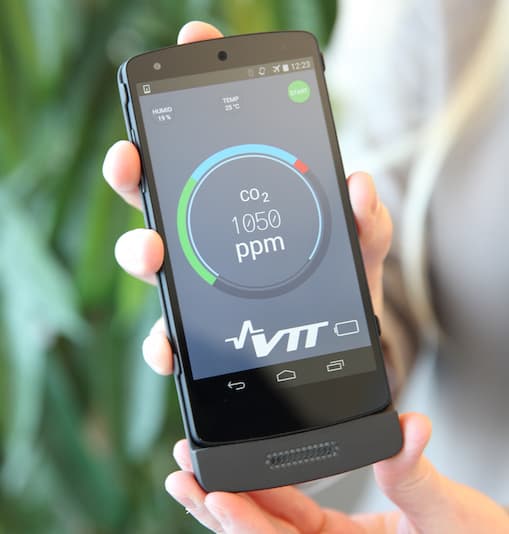Tiny Gas Sensor Developed To Detect Internal Air Levels In Body During Sleep
VTT is a technical research firm based out of Finland that has over 70 years of experience in doing science-based top-level research. Recently, the scientists at VTT research have developed a minuscule gas sensor that can be connected with a smartphone or tablet to conduct gas measurements inside human body. For instance, using a mobile healthcare app in conjunction with this gas sensor, you can have your smartphone measure the quality of your sleep with great precision by gauging CO2 quantities in your body.

Recent findings have shown that internal air quality in the human bodies is of great significance as appropriate Carbon dioxide levels in body can result in daily efficiency and precision in workplace. Sensor developers are therefore getting increasingly interested to measure gas concentrations using the most handy gadget available i.e. your smartphone. In addition to that, the reach of Internet of Things (IoT) devices is expanding at a really fast rate. This is enabling developers to have access to single sensors or sensor networks that gather such observations from various environmental factors with ease.
The tiny gas sensor, developed by VTT research team's Senior Scientist Rami Mannila, uses adjustable optical filters known as Fabry-Pérot interferometers, that have been previously used for applications based on spectroscopy - such as environmental monitoring via drones or nano-satellites, various hyper-spectral cameras, the early detection of skin cancer as well as in fuel analysis for minimizing the emission rate.
The gas sensor's working happens via channeling of light through the sample that needs to be analysed. By measuring the penetration level at various light wavelengths, the composition of the sample is determined. For example - CO2 is identified based on its strong absorption of light at a wavelength of 4.2 µm. Moreover, it is possible to differentiate other gases or substances in the sample compound at the same time by determining the spectrum of their absorption peaks at various infrared wavelengths.
What are your thoughts about using gas sensors in your Android, iOS and Windows smartphones for health and sleep monitoring? Share with us in comments below.
Source: #-Link-Snipped-#

Recent findings have shown that internal air quality in the human bodies is of great significance as appropriate Carbon dioxide levels in body can result in daily efficiency and precision in workplace. Sensor developers are therefore getting increasingly interested to measure gas concentrations using the most handy gadget available i.e. your smartphone. In addition to that, the reach of Internet of Things (IoT) devices is expanding at a really fast rate. This is enabling developers to have access to single sensors or sensor networks that gather such observations from various environmental factors with ease.
The tiny gas sensor, developed by VTT research team's Senior Scientist Rami Mannila, uses adjustable optical filters known as Fabry-Pérot interferometers, that have been previously used for applications based on spectroscopy - such as environmental monitoring via drones or nano-satellites, various hyper-spectral cameras, the early detection of skin cancer as well as in fuel analysis for minimizing the emission rate.
The gas sensor's working happens via channeling of light through the sample that needs to be analysed. By measuring the penetration level at various light wavelengths, the composition of the sample is determined. For example - CO2 is identified based on its strong absorption of light at a wavelength of 4.2 µm. Moreover, it is possible to differentiate other gases or substances in the sample compound at the same time by determining the spectrum of their absorption peaks at various infrared wavelengths.
What are your thoughts about using gas sensors in your Android, iOS and Windows smartphones for health and sleep monitoring? Share with us in comments below.
Source: #-Link-Snipped-#
0
